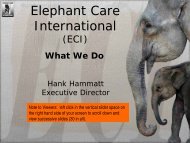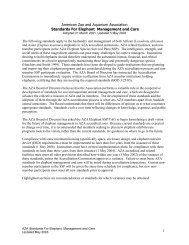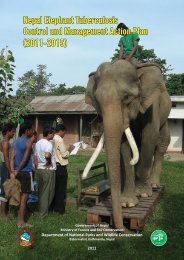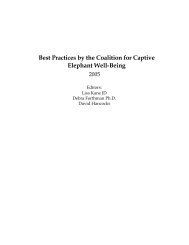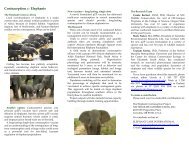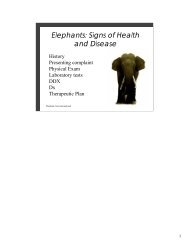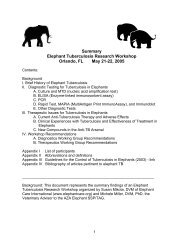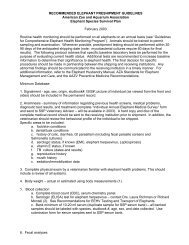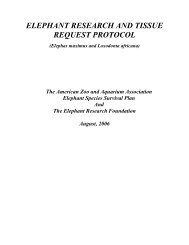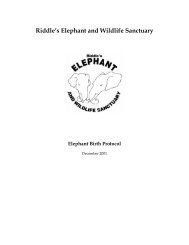Elephants Elephants - Wildpro - Twycross Zoo
Elephants Elephants - Wildpro - Twycross Zoo
Elephants Elephants - Wildpro - Twycross Zoo
- No tags were found...
Create successful ePaper yourself
Turn your PDF publications into a flip-book with our unique Google optimized e-Paper software.
ACTIVITY<strong>Elephants</strong> spend about 16 hours a day feeding. They sleep four or five hoursin 24, sometimes lying down thus, although primarily diurnal, they are activein the hours of darkness. <strong>Elephants</strong> perform remarkable movements andpostures; they can roll, kneel, squat, sit on their haunches and climb up verysteep slopes (Estes 1991). However they cannot run or jump but only walk atvarying speeds.SOCIAL ORGANISATIONThe basic elephant social unit is a mother and her offspring. A family unitbeing a group of related females, consisting of a mother and young with herown mature daughters and offspring (Moss and Poole 1983). The matriarch,who will be the oldest, largest and possibly even post reproductive female,sets the activity, direction and rate of movement of the herd. The leadershipand experience of the matriarch is thought to be of great importance and it hasbeen suggested that there may be higher per capita reproductive success ingroups led by older females due to their enhanced discriminatory abilities(McComb et al 2001). In Manyara the average size of a family unit was 10,these units grouped together to form larger kinship or ‘bond’ groups, whichmay consist of as many as 50 animals. When the number of elephantsincreases beyond a critical number a new matriarchy splits off but will remainas part of the same kinship or bond group. These kinship groups probablyform part of a larger association, often termed ‘clans’, which would explainobservations of gatherings of up to 100 animals or more (Eltringham 1982).The current suggestion for elephant social organisation is therefore a coregroup of a family unit, these units being further associated in bond groups.Bond groups are probably comprised of closely related individuals resultingfrom the fission of family groups. Bond groups come together in clans (of upto 55 animals in Amboseli), which combine to form sub-populations and thusthe population of an area. Although most detailed work on socialorganisation is from African elephants, clans have also been identified inAsian elephants (Sukumar 1992) and families do split and come together(McKay 1973). Eisenberg suggests a range of 8-21 animals for bond groups inSri Lanka, which may split into family units. A more recent study in Sri Lankafound bond groups of 22-58 animals which split into family groups comprisedof between one and four reproducing females (Heine et al 2001). Datagathered by McKay in Sri Lanka shows a splitting of groups of females withyoung infants (a nursing unit) from groups with juveniles (a juvenile careunit), this seems to be because females with infants at heel associated morewith other similar females; between these groups there is a degree offlexibility and interchange of individuals (Kurt 1974) (McKay 1973). In generalherd sizes differ between populations, between wet and dry seasons, andbetween habitat types, e.g. desert elephants disperse over large areas inrelatively small groups and probably rely on infrasound to communicatebetween groups (Lee 1991b).The most detailed study of relatedness between animals in wild Asianelephants was carried out using mitochondrial DNA studies from dung of28



